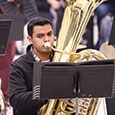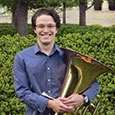Through studies and discussions with my mentors Dan Perantoni, Thomas Stein, and Scott Tegge, I have changed my approach to airflow, embouchure and buzz, and articulation, and these ideas affect how I teach these concepts to developing players. Here are a few strategies to address these common misconceptions when teaching tuba.

Airflow
Brass teachers frequently use such phrases as fog up a mirror or use dark, thick air to teach young players about airflow. These images remind students to slow down and widen their air column to produce the low frequency vibrations needed for the tessitura of the instrument. However, they can lead to air that lacks directionality and can foster a wide, woofy tone without a characteristic center and quality. Though these truisms might help initially with basic tone production, they encourage bad habits not conducive to good tone quality later. Here are a couple of concepts and exercises that may work better.
To help reframe the airflow concept, I encourage students to think of the inside of the mouth as a funnel with the tallest part towards the back and focusing at the lips. Using an OH syllable establishes a good oral cavity shape. Instead of asking students to imagine fogging up a mirror, tell them to breathe and blow from/through the lips, creating better directionality to the air and establishing correct aperture. Instead of blowing from the throat or back of the mouth, the air is most active at the embouchure, establishing a richer tone quality with more characteristic core.
One activity that helps visualize this directional airflow is to use an object such as a piece of paper or a paper pinwheel held a few inches away from the embouchure. Ask students to try breathing exercises and wind patterns on various rhythms while blowing on these objects. Students can also blow on their hand held up at that distance to feel their airflow.
Embouchure/Buzz
Some technical aspects of embou-chure setup will help with airflow and vice versa. The suggestion to use slow, thick air and drop the jaw to establish a correct oral cavity can produce a lack of focus at the lips via too wide an aperture, which means the lips cannot vibrate efficiently. The funnel concept and blowing from the lips helps to form a smaller aperture.
For the muscular aspects of the embouchure, players can be too relaxed. Just as a ligature supports a single reed, the corners of the mouth offer structural support for the lips to vibrate freely in response to the air. Instead of firming or tightening the corners, consider asking students to gently pull the corners slightly in and down, imagining like they are walrus tusks – a concept borrowed from the oboe world. This reduces excess facial tension and smiling effects with the corners without becoming so relaxed that the corners blow out and cheeks puff. Free buzzing (buzzing away from the mouthpiece) in small doses is a healthy practice for intermediate and advanced students to build this structure.
When performing lip slurs or changing partials, young students instinctively muscle the changes from the embouchure. Remind students that the lips respond to the air, and subtle changes to the focus and speed of the airflow help shift between different partials more than pivoting the airstream up and down as is often initially taught. The up/down airflow pivot, when too extreme, disrupts an efficient embouchure and buzz. Instead, encourage blowing center with minimal changes to get to the next partial.
Articulation
This also relates to concepts of airflow and embouchure setup. With all articulations, sound stems from the air, never from the physical tongue movement. The physical mechanism clarifies and focuses the sound, but air is always the main event. With the funnel model and OH syllable, the tongue will naturally be in a lower position without having to force it lower by dropping the jaw.
One common misconception is that tongue placement for all brass articulations is the same and uses the same consonant vocalizations. Maxims such as tip of the tongue behind the teeth or placement where the teeth and gumline meet raises the front of the tongue too high and disrupts the natural funnel airflow. Instead, the tongue placement for articulation should be lower towards the bottom of the teeth and back of the lips, but never through the lips, of course.
Have students imagine spitting out a grain of rice or watermelon seed from the lips. The tongue movement becomes more front-to-back rather than up-down and complements the blow from the lips concept with directionality to the air. This also encourages students not to articulate forcefully. Creating different articulation weights stems from the air, with the physical tonguing remaining relatively light and focusing the airflow for articulation.
In general, developing tuba players try to perform staccato and marcato articulations that are too short, cutting off the resonance of the tone. Based on the acoustics of the range and tessitura of the tuba, make sure your developing tubists play these articulations with resonance and full tone. With advanced techniques of double and triple tonguing, have students try wind patterns on their hand, paper, or paper windmills to emphasize directional air and light articulation.
As music educators, we all use certain sayings in lessons, sectionals, and full ensemble settings. Though we continually update those suggestions through professional development, we are sometimes guilty of falling back on clichés that don’t reflect best practices for teaching a specific instrument. All of the above suggestions are fundamental technical advice to help students achieve a beautiful, musical sound on the tuba.
Even more than this advice, the greatest teacher is aural imitation. Students should listen to the best performers on the tuba (or any instrument, voice, or ensemble), internalize those sounds into their aural imaginations, and emulate them on their instruments. With the multitude of resources available today, this has never been easier. A few tuba artists of many that represent a variety of styles to consider as models include: Daniel Perantoni, Carol Jantsch, David Zerkel, Gene Pokorny, Roland Szentpali, and Sergio Carolino. Aural imagination with good fundamentals sets students up for success and ideally curiosity and hunger to grow as musicians who happen to play the tuba.






